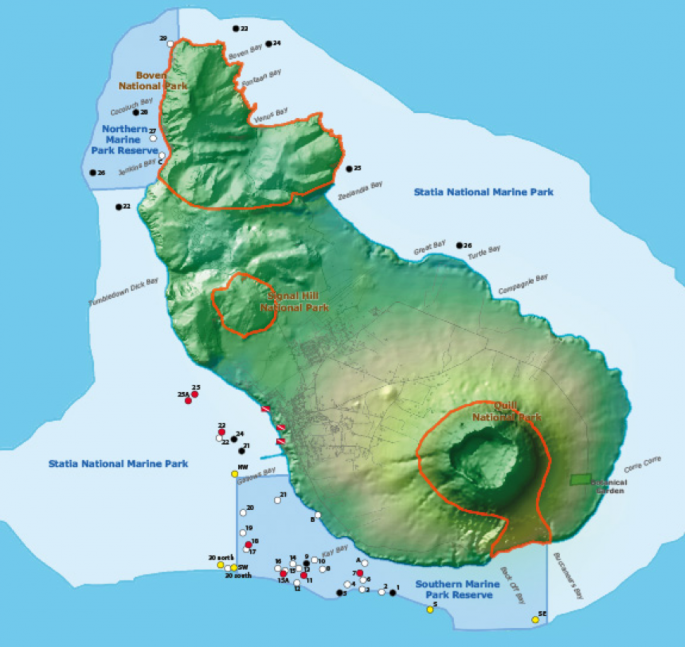DCNA is partnering with the Caribbean Islands Manta Conservation Program, an affiliate project of the Manta Trust, and Observation.org to track local manta rays and devil rays within the Dutch Caribbean. Through individuals reporting their (old and new) sightings and interactions with mantas and devil rays, researchers are hoping to learn more about local populations to shed light on this mysterious species.
Manta Rays and Devil Rays
Manta and devil rays are highly charismatic and have some of the largest brains of all fish species. Although they can be found throughout tropical, subtropical and temperate waters worldwide, they are highly threatened, often victims of fishing. Whether caught as by-catch or targeted for their gill plates, which are valuable on the black market and used in Traditional Chinese Medicine, populations of this species are dwindling, leaving them endangered.
Mantas and devil rays are some of the largest of the ray family, reaching sizes of up to 7 meters wide. Until only a few years ago, manta rays were thought to be a single species of their own genus, but they are now considered to be part of the mobulid genus, along with the devil rays. Two distinct species of manta ray have been identified, yet a third is likely. Oceanic manta rays (Mobula birostris) are the largest mobulids and are found worldwide, typically in open ocean water. Reef manta rays (Mobula alfredi) are found in the Indian and West Pacific Oceans, more commonly along coastlines and coral reefs. A third species of manta ray, the Caribbean manta ray or Mobula c.f. birostris has been proposed, and scientists are working to confirm the distinct species. Caribbean manta rays are likely sympatric to the oceanic manta ray and found in the Atlantic, the Caribbean Sea and the Gulf of Mexico.
All mobula species are filter feeders, swimming along with their mouths open, sieving out zooplankton and krill from the water. They’re known to use creative techniques involving repeated somersaults to create a cyclone effect, trapping their food in the water column. Unlike stingrays, they have no stinger or barb in their tail and are completely harmless to humans. Manta rays and devil rays will always be on the move through the water, as they are ram-ventilators and must continuously swim to run water over their gills. They can swim very quickly but they can also be quite curious about divers and will often circle around to investigate, especially when divers or snorkelers are calm in the water.
Manta rays often make regular visits to the reef, particularly to known cleaning stations where smaller fish feed off larger fish, removing parasites and dead skin. Knowing these locations and tracking regular visitors can help researchers understand more about mantas’ life cycles and migration patterns. Many of the sightings from the Dutch Caribbean have been of feeding manta rays in areas of dense plankton concentration.
Manta rays can be identified as individuals by the unique spot pattern on their ventral side or belly. Using a photograph of these spots, researchers can track individuals over time, perhaps across international borders. Anyone with a camera can take a photo of manta ray and all images are helpful regardless of showing the mantas spot pattern. Even images taken from land or a boat can be helpful in determining seasonal movements and aggregation sites.
Around the islands of the Dutch Caribbean, Mobula birostris and Mobula c.f. birostris as well as two species of devil ray, Mobula hypostoma and Mobula tarapacana have been identified. Sightings appear to be infrequent and unpredictable; however, researchers are hoping to learn more with increased data and reports.
Highly Threatened
Although manta rays are long-lived, with expected life spans of 30-50 years, females are slow to sexually mature and tend to only have one pup every two to five years. Threatened by overfishing, these species have seen a drastic decrease in their numbers worldwide. Luckily since 2011, mantas have been protected within international waters by the Convention on Migratory Species as well as a variety of local conservation efforts such as the establishment of the Yarari Sanctuary in the Dutch Caribbean. Much of this has been driven by countries realizing the economic value these species can generate, as many tourists will travel from around the world to see these creatures first hand. In fact, one study estimated that a single ray could generate up to one million dollars in its lifetime.
In 2020, the International Union for the Conservation of Nature (IUCN) changed the status of oceanic manta rays from vulnerable to endangered, signifying that they need further conservation worldwide. This species and the putative third species, the Caribbean Manta Ray, are the two most sighted in the Dutch Caribbean waters. It’s essential to continue researching these species to protect them and their habitats for the future.
The Project
Together with the Caribbean Islands Manta Conservation Program, an affiliate project of the Manta Trust and Observation.org, DCNA is working to catalog local manta populations and educate residents and visitors about these incredible species. By reporting sightings and interactions with mantas in the Dutch Caribbean, individuals can contribute to this database. Each sighting can be validated using either an automatic or manual method, especially with the manta conservation program staff validating species for Observation.org.
The Manta Trust collects information on manta ray sightings worldwide, and they have now recorded more than 120 encounters throughout the Dutch Caribbean. DCNA and the Caribbean Islands Manta Conservation Program are currently working to build a regional database of ID photos from citizen scientist and researchers. More than 20 individual manta rays have been identified in the Dutch Caribbean, and lucky photographers have named some of these individuals. Recently, Caribbean manta rays from Bonaire were named Caicai (reported by Bas Tol) and Ari (reported by Arinae Scharpenberg). In Aruba, an oceanic manta ray was named Dushi (reported by Danielle de Kool and Rudolf Ulloa). If you are the first to photograph the spot pattern of a manta ray and submit it for the database, you’ll also be given the opportunity to name the manta.
Report your sightings
Please report any sightings or photos (new or old) you have of manta rays, or any other unique species on our observation.org page. The current goal is to increase data collection to highlight multiple sightings of individuals and to determine what areas mantas tend to revisit. With increased submissions, researchers hope to determine whether there are any aggregation sites or seasonal patterns of sightings around the Caribbean islands. Observation.org and DCNA will share your photos with Manta Trust researchers; however you can also submit your photos and videos from anywhere in the world directly to www.mantatrust.org/idthemanta, an international manta tracking database of the Manta Trust.
If you prefer, or for more information regarding your sighting, you can email photos or videos (make sure to include the date and location) to nicole.pelletier@mantatrust.org. Photos can also be sent through the Caribbean Islands Manta Conservation Program social media pages on Facebook and Instagram. If uploading images to social media, particularly Instagram, tag #Caribbeanislandsmanta in your uploads to make sure these images are easily found and included in the global database.
We look forward to hearing about your encounters and learning more about these incredible species in the Dutch Caribbean.
Photo credit: Peter Verhoog/DutchSharkSociety/PEW (all rights reserved)




